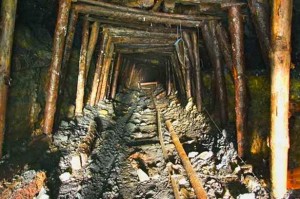“In those tunnels under the mountain, I saw the whole town as if from far away, above or below, the houses all through a mist, and the chapel, and the stone bench that would be my home. Everything so small, and the hills so high they were become true mountains. Clouds passing over the sun sending great black shadows over the town…It was dreadful, terrible. Beautiful.” –Ianto Passchendaele Jenkins
 It has been two years since I have added a new book to my list of All-Time Favorites, but that has just changed with the release of this novel which deserves a special place on my Favorites list. Set in the mining country of southern Wales, Vanessa Gebbie’s incandescent new novel captures the cadences and speech patterns that lovers of Dylan Thomas’s Under Milk Wood have celebrated for years, and as I read the book (as slowly as possible), I felt as if Richard Burton, the Welsh narrator of Under Milk Wood, were whispering in my ear. A collection of stories recounted by Ianto Passchendaele Jenkins, a beggar who lives on a stone bench in front of a disused chapel, the novel eventually becomes the history of the small Welsh mining town itself, and readers will come to know all the characters and their families going back for three generations. The emotional power of this novel is overwhelming without becoming sentimental or syrupy.
It has been two years since I have added a new book to my list of All-Time Favorites, but that has just changed with the release of this novel which deserves a special place on my Favorites list. Set in the mining country of southern Wales, Vanessa Gebbie’s incandescent new novel captures the cadences and speech patterns that lovers of Dylan Thomas’s Under Milk Wood have celebrated for years, and as I read the book (as slowly as possible), I felt as if Richard Burton, the Welsh narrator of Under Milk Wood, were whispering in my ear. A collection of stories recounted by Ianto Passchendaele Jenkins, a beggar who lives on a stone bench in front of a disused chapel, the novel eventually becomes the history of the small Welsh mining town itself, and readers will come to know all the characters and their families going back for three generations. The emotional power of this novel is overwhelming without becoming sentimental or syrupy.
 Telling his stories in exchange for food and coffee, often outside the local movie theatre, Ianto is always haunted by the explosion and collapse of the Kindly Light mine, which killed eighty-five townsmen three generations ago. He, a child whose father was dying from lung complications after working the mines for most of his life, was forced to go to work in the mines himself to support the family at age twelve. After working for only a few terrifying days, however, Ianto found himself inside the mine when it exploded. His rescue was an enormous disappointment for the dozens of the miners’ wives and mothers – who were hoping instead that the rescued person would be someone’s husband or father – and when, upon his rescue, this naive and terrified twelve-year-old tearfully announced that the explosion and deaths were all his fault, he became the scapegoat for the emotional horrors of the community. Now, as an old man, he nears the end of his life, one spent in penance for actions, real or imagined, which have prevented him from having a life of his own since he was twelve.
Telling his stories in exchange for food and coffee, often outside the local movie theatre, Ianto is always haunted by the explosion and collapse of the Kindly Light mine, which killed eighty-five townsmen three generations ago. He, a child whose father was dying from lung complications after working the mines for most of his life, was forced to go to work in the mines himself to support the family at age twelve. After working for only a few terrifying days, however, Ianto found himself inside the mine when it exploded. His rescue was an enormous disappointment for the dozens of the miners’ wives and mothers – who were hoping instead that the rescued person would be someone’s husband or father – and when, upon his rescue, this naive and terrified twelve-year-old tearfully announced that the explosion and deaths were all his fault, he became the scapegoat for the emotional horrors of the community. Now, as an old man, he nears the end of his life, one spent in penance for actions, real or imagined, which have prevented him from having a life of his own since he was twelve.
 The stories he tells are inspired by the friendship which evolves between Ianto and Laddy Merridew, a red-haired nine-year-old who has just come to live with his grandmother following the breakup of his parents’ marriage. In an introduction overlaid with symbolism, Laddy, weeping from the mockery of schoolboys because his clothes smell of mothballs, introduces himself to Ianto by saying, “My name is Laddy Merridew. I’m a cry-baby. I’m sorry.” Though Ianto does not stop walking or even look back at the needy boy, he responds, “And my name is Ianto Jenkins. I am a coward. And that’s worse.”
The stories he tells are inspired by the friendship which evolves between Ianto and Laddy Merridew, a red-haired nine-year-old who has just come to live with his grandmother following the breakup of his parents’ marriage. In an introduction overlaid with symbolism, Laddy, weeping from the mockery of schoolboys because his clothes smell of mothballs, introduces himself to Ianto by saying, “My name is Laddy Merridew. I’m a cry-baby. I’m sorry.” Though Ianto does not stop walking or even look back at the needy boy, he responds, “And my name is Ianto Jenkins. I am a coward. And that’s worse.”
Ianto’s stories all have mystical significance, and how much “truth” resides in them, in terms of real life events, becomes irrelevant as their emotional and personal truth and their family significance are revealed. The cumulative impact of Ianto’s many stories provides a unique look at life in a small Welsh mining village, but just as importantly, it provides a look at Ianto’s own life since the mining disaster which determined the outcomes of families for generations.
 “The Woodwork Teacher’s Tale,” about Icarus Evans, the grandson of a man who died in Kindly Light, tells of Laddy’s attempts to befriend him. Icarus has been teaching woodworking in the local school for thirty years, and each year he has given his students one final assignment, telling them that “When you make me a feather out of wood, only then are you a real carpenter.” For thirty years, his students have tried to accomplish this miracle, and he has kept their separate, failed efforts in boxes labeled by year. “The Half-Wit’s Tale” and the “Deputy Bank Manager’s Tale” overlap. “Half” Harris, intellectually challenged and “born twice,” loves fishing, and fishes in the local river for the junk that others throw away, carting his catch home in an old pram. The deputy bank manager, Matty Harris (“no relation”) also loves fishing, and is always looking for the perfect fish. The intersection of their lives changes both of them forever.
“The Woodwork Teacher’s Tale,” about Icarus Evans, the grandson of a man who died in Kindly Light, tells of Laddy’s attempts to befriend him. Icarus has been teaching woodworking in the local school for thirty years, and each year he has given his students one final assignment, telling them that “When you make me a feather out of wood, only then are you a real carpenter.” For thirty years, his students have tried to accomplish this miracle, and he has kept their separate, failed efforts in boxes labeled by year. “The Half-Wit’s Tale” and the “Deputy Bank Manager’s Tale” overlap. “Half” Harris, intellectually challenged and “born twice,” loves fishing, and fishes in the local river for the junk that others throw away, carting his catch home in an old pram. The deputy bank manager, Matty Harris (“no relation”) also loves fishing, and is always looking for the perfect fish. The intersection of their lives changes both of them forever.
 “The Baker’s Tale” tells of Andrew Bowen, who is not a baker at all, living in a “bakery” which is not a bakery, though his grandfather was a baker, and explains how he became the person who created a town ceremony that takes place each year. “The Window Cleaner’s Tale” is an unusual love story. “The Gas Meter Emptier’s Tale” is one of the most revealing of the town’s culture, and its main character, James Little, became one of my favorites, a man whose father was branded a thief and who always felt victimized by those who rejected his father. At the end, Peter Philips, the Collier, an illiterate (probably dyslexic) boy whose father was determined that he would be a scholar, not a miner, ultimately provides insights into the young Ianto Jenkins. Ianto Jenkins’s own story, revealed slowly during the whole novel in interludes scattered among the other tales, provides the reasons he always blamed himself for the mine disaster, and a reader would have to have a heart of coal not to respond to this wrenching conclusion.
“The Baker’s Tale” tells of Andrew Bowen, who is not a baker at all, living in a “bakery” which is not a bakery, though his grandfather was a baker, and explains how he became the person who created a town ceremony that takes place each year. “The Window Cleaner’s Tale” is an unusual love story. “The Gas Meter Emptier’s Tale” is one of the most revealing of the town’s culture, and its main character, James Little, became one of my favorites, a man whose father was branded a thief and who always felt victimized by those who rejected his father. At the end, Peter Philips, the Collier, an illiterate (probably dyslexic) boy whose father was determined that he would be a scholar, not a miner, ultimately provides insights into the young Ianto Jenkins. Ianto Jenkins’s own story, revealed slowly during the whole novel in interludes scattered among the other tales, provides the reasons he always blamed himself for the mine disaster, and a reader would have to have a heart of coal not to respond to this wrenching conclusion.
Filled with unforgettable descriptions and emotionally moving insights into people of all types, The Coward’s Tale recreates an entire town, and as the characters develop and overlap throughout the book, the wonder of this author’s achievement expands. I have never enjoyed sentimental and cliché-driven novels in which the author “pushes buttons” to create artificial sentiment, so when I tell you that I loved this novel for the very real feelings and genuine sadness it conjures, I do so in the hope that you will eventually agree that this novel is special, different, and honest in its depictions of the lives of miners in a small town in Wales, and ultimately, of other thoughtful people who must deal with tragedies within a closed system of community values.
The author’s website is here: http://www.vanessagebbie.com/
Photos, in order: The author’s photo, by Andrew Hasson, appears on http://newwritingsouth.com
The hands holding coal, by Robert Nickelsburg, Getty Images, is from http://www.guardian.co.uk
The last two photos are posted to honor the miners who died in the Gleision Colliery in Wales in September, 2011. The photo of the entrance to the flooded mine is from http://www.telegraph.co.uk/ The iconic photo of the exhausted rescue workers is from http://www.boston.com. Four trapped miners died in this accident. Working in one of the most dangerous professions in the world, miners continue to give their lives to the mines as they have done for generations.
